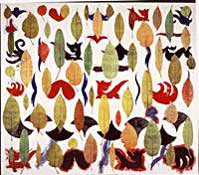Philip Taaffe
Philip Taaffe (Elizabeth, New Jersey 1955) studied at Cooper Union in New York. His first solo exhibition was at the Roger Litz Gallery in New York in 1982, and since then his work has established itself as one of the most personal and intense voices in contemporary painting. During the eighties Taaffe made his own personal recreations of images associated with Barnett Newman, Ellsworth Kelly and various Op Art artists. His paintings were linked with the Neo-Geo group (which included artists such as Ross Bleckner and Peter Halley) and with appropriationism, but gradually his unclassifiable personality became apparent. Philip Taaffe is an innovator in terms of technique: his pictures are a personal mixture of careful processes involving printing, collage and painting that evoke the formal and chromatic intensity of Islamic miniatures, like a collage juxtaposing bright layers of contrasting surfaces and textures. It is on a conceptual level, however, that Philip Taaffe’s work acquires its greatest importance. By blending different artistic traditions, from the most recent stages of modernity to the most exotic civilisations, he suggests the possibility of a harmonious co-existence of all races and cultures. In his work he proposes a mental and emotional journey by the use of symbols that proliferate stimuli, creating the possibility of multiple interpretations of a reality previously hidden from us. In his works Taaffe incorporates found images, ornamental forms that act as cultural signs of historical and geographical sources deriving from very diverse origins. We are confronted with evocations of Islamic architecture, forms taken from Celtic illuminated manuscripts, Egyptian hieroglyphics, Arabic calligraphy, textile designs from Mediterranean, American and oriental cultures, ornaments from Japanese sword guards, wrought-iron latticework, graphic patterns and ornamental designs. His interest in cultures in different geographical settings and at different moments in their history has led Philip Taaffe to travel frequently to the Far East, India, South America and North Africa, and from 1988 to 1991 he lived in Naples. During the nineties he incorporated images of nature composites and scientific elements, such as specimens of flora and fauna (leaves, insects or starfish), which -unlike his use of craft motifs and forms and architectural structures- he introduced as representational elements devoid of symbolic function. These elements are incorporated as if they were abstract signs floating on gestural backgrounds, like the signs in Miro’s Constelaciones (Constellations). The exhibition in the IVAM’s Centre del Carme is the first international retrospective of Philip Taaffe’s work. It presents some fifty works, including large-format paintings made during the period from 1980 to the present and a series of pieces produced at the beginning of his career which have not previously been exhibited. The catalogue that accompanies the exhibition contains reproductions of all the works exhibited and includes critical texts on Philip Taaffe’s work by Robert Rosenblum and Enrique Juncosa, together with a conversation between the artist and the poet Robert Creeley.



